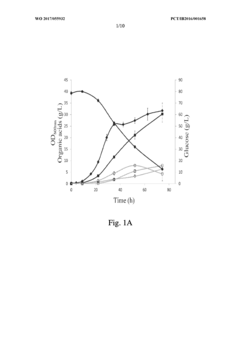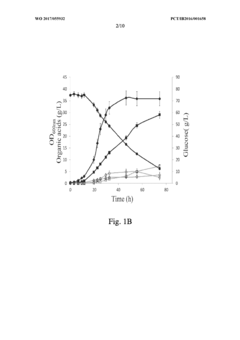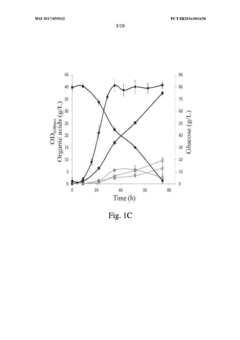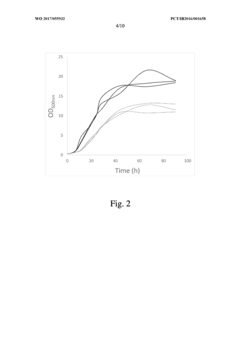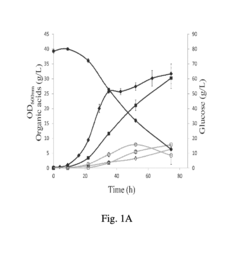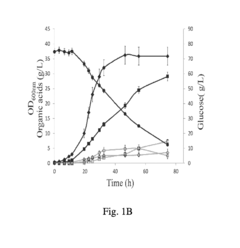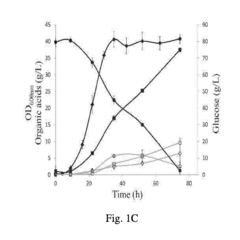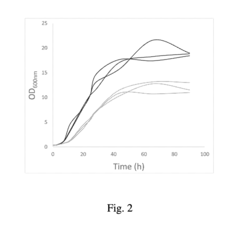Propionic Acid in Organic and Hybrid Chemical Syntheses
JUL 3, 20259 MIN READ
Generate Your Research Report Instantly with AI Agent
Patsnap Eureka helps you evaluate technical feasibility & market potential.
Propionic Acid Synthesis Evolution and Objectives
Propionic acid synthesis has undergone significant evolution since its discovery in the mid-19th century. Initially produced as a byproduct of wood distillation, the focus shifted towards more efficient and sustainable production methods. The primary objective in propionic acid synthesis has been to develop economically viable and environmentally friendly processes that can meet the growing industrial demand.
The early 20th century saw the emergence of petrochemical-based synthesis routes, particularly the Reppe process using ethylene, carbon monoxide, and steam. This method dominated industrial production for decades due to its cost-effectiveness and scalability. However, concerns over fossil fuel dependency and environmental impact led to a renewed interest in alternative synthesis pathways.
In recent years, the field has witnessed a surge in research aimed at developing bio-based production methods. Fermentation processes using various microorganisms, such as Propionibacterium freudenreichii and genetically engineered Escherichia coli strains, have gained significant attention. These approaches align with the growing trend towards sustainable and renewable resources in chemical synthesis.
Concurrently, advancements in catalytic chemistry have opened new avenues for propionic acid synthesis. Novel heterogeneous catalysts and process intensification techniques have been explored to enhance reaction efficiency and selectivity. The integration of continuous flow reactors and microreactor technology has also contributed to improved process control and product quality.
The current objectives in propionic acid synthesis research are multifaceted. Firstly, there is a strong focus on optimizing bio-based production methods to achieve higher yields and purity levels comparable to traditional petrochemical routes. This includes strain development, metabolic engineering, and fermentation process optimization.
Secondly, researchers are exploring hybrid approaches that combine biological and chemical synthesis steps. These integrated processes aim to leverage the strengths of both methodologies, potentially offering more flexible and efficient production systems.
Thirdly, there is ongoing work to develop novel catalysts and reaction conditions that enable direct synthesis of propionic acid from renewable feedstocks. This includes the valorization of biomass-derived platform chemicals and the utilization of CO2 as a carbon source.
Lastly, the field is moving towards more sustainable and circular production models. This involves the development of closed-loop systems, waste valorization strategies, and the integration of propionic acid synthesis with other industrial processes to maximize resource efficiency.
As research in propionic acid synthesis continues to evolve, the overarching goal remains to establish economically competitive and environmentally sustainable production methods that can meet the diverse needs of the chemical industry while aligning with global sustainability objectives.
The early 20th century saw the emergence of petrochemical-based synthesis routes, particularly the Reppe process using ethylene, carbon monoxide, and steam. This method dominated industrial production for decades due to its cost-effectiveness and scalability. However, concerns over fossil fuel dependency and environmental impact led to a renewed interest in alternative synthesis pathways.
In recent years, the field has witnessed a surge in research aimed at developing bio-based production methods. Fermentation processes using various microorganisms, such as Propionibacterium freudenreichii and genetically engineered Escherichia coli strains, have gained significant attention. These approaches align with the growing trend towards sustainable and renewable resources in chemical synthesis.
Concurrently, advancements in catalytic chemistry have opened new avenues for propionic acid synthesis. Novel heterogeneous catalysts and process intensification techniques have been explored to enhance reaction efficiency and selectivity. The integration of continuous flow reactors and microreactor technology has also contributed to improved process control and product quality.
The current objectives in propionic acid synthesis research are multifaceted. Firstly, there is a strong focus on optimizing bio-based production methods to achieve higher yields and purity levels comparable to traditional petrochemical routes. This includes strain development, metabolic engineering, and fermentation process optimization.
Secondly, researchers are exploring hybrid approaches that combine biological and chemical synthesis steps. These integrated processes aim to leverage the strengths of both methodologies, potentially offering more flexible and efficient production systems.
Thirdly, there is ongoing work to develop novel catalysts and reaction conditions that enable direct synthesis of propionic acid from renewable feedstocks. This includes the valorization of biomass-derived platform chemicals and the utilization of CO2 as a carbon source.
Lastly, the field is moving towards more sustainable and circular production models. This involves the development of closed-loop systems, waste valorization strategies, and the integration of propionic acid synthesis with other industrial processes to maximize resource efficiency.
As research in propionic acid synthesis continues to evolve, the overarching goal remains to establish economically competitive and environmentally sustainable production methods that can meet the diverse needs of the chemical industry while aligning with global sustainability objectives.
Market Analysis for Propionic Acid Applications
The global market for propionic acid has been experiencing steady growth, driven by its versatile applications in various industries. The food and beverage sector remains the largest consumer of propionic acid, primarily due to its use as a preservative in baked goods, dairy products, and animal feed. The increasing demand for packaged and processed foods, coupled with the growing awareness of food safety, has significantly contributed to the market expansion.
In the chemical synthesis sector, propionic acid plays a crucial role as a precursor for various organic compounds, including cellulose acetate propionate, herbicides, and pharmaceuticals. The rising demand for these end-products has positively impacted the propionic acid market. Additionally, the growing trend towards sustainable and bio-based chemicals has opened new avenues for propionic acid applications in green chemistry.
The agriculture industry represents another significant market for propionic acid, particularly in animal feed preservation. As global meat consumption continues to rise, the demand for high-quality animal feed additives has increased, further boosting the propionic acid market. Moreover, the use of propionic acid in grain preservation has gained traction, especially in regions with high humidity and risk of mold growth.
In terms of regional distribution, North America and Europe have traditionally been the largest markets for propionic acid, owing to their well-established food and beverage industries and stringent food safety regulations. However, the Asia-Pacific region is emerging as a rapidly growing market, driven by increasing industrialization, changing dietary habits, and rising disposable incomes.
The market dynamics are also influenced by the raw material prices, particularly propylene, which is the primary feedstock for propionic acid production. Fluctuations in propylene prices can significantly impact the overall profitability of propionic acid manufacturers. This has led to increased research efforts in developing alternative production methods, including bio-based routes, to reduce dependency on petrochemical feedstocks.
Looking ahead, the propionic acid market is expected to continue its growth trajectory, with new applications in biodegradable plastics and eco-friendly solvents presenting promising opportunities. The increasing focus on sustainable development and circular economy principles is likely to drive innovation in propionic acid production and applications, potentially reshaping the market landscape in the coming years.
In the chemical synthesis sector, propionic acid plays a crucial role as a precursor for various organic compounds, including cellulose acetate propionate, herbicides, and pharmaceuticals. The rising demand for these end-products has positively impacted the propionic acid market. Additionally, the growing trend towards sustainable and bio-based chemicals has opened new avenues for propionic acid applications in green chemistry.
The agriculture industry represents another significant market for propionic acid, particularly in animal feed preservation. As global meat consumption continues to rise, the demand for high-quality animal feed additives has increased, further boosting the propionic acid market. Moreover, the use of propionic acid in grain preservation has gained traction, especially in regions with high humidity and risk of mold growth.
In terms of regional distribution, North America and Europe have traditionally been the largest markets for propionic acid, owing to their well-established food and beverage industries and stringent food safety regulations. However, the Asia-Pacific region is emerging as a rapidly growing market, driven by increasing industrialization, changing dietary habits, and rising disposable incomes.
The market dynamics are also influenced by the raw material prices, particularly propylene, which is the primary feedstock for propionic acid production. Fluctuations in propylene prices can significantly impact the overall profitability of propionic acid manufacturers. This has led to increased research efforts in developing alternative production methods, including bio-based routes, to reduce dependency on petrochemical feedstocks.
Looking ahead, the propionic acid market is expected to continue its growth trajectory, with new applications in biodegradable plastics and eco-friendly solvents presenting promising opportunities. The increasing focus on sustainable development and circular economy principles is likely to drive innovation in propionic acid production and applications, potentially reshaping the market landscape in the coming years.
Current Challenges in Propionic Acid Production
The production of propionic acid faces several significant challenges that hinder its widespread adoption and efficient synthesis. One of the primary issues is the high cost associated with traditional production methods, particularly those relying on petrochemical feedstocks. The volatility of oil prices and the environmental concerns surrounding fossil fuel-based processes have prompted researchers to explore alternative production routes.
Another major challenge lies in the low yield and selectivity of current production processes. Many existing methods struggle to achieve high conversion rates of raw materials to propionic acid, leading to inefficient resource utilization and increased production costs. This issue is particularly pronounced in fermentation-based processes, where competing metabolic pathways can divert resources away from propionic acid production.
The purification of propionic acid from reaction mixtures presents another significant hurdle. Separation techniques often require substantial energy input and can be complex, especially when dealing with aqueous solutions or fermentation broths. The presence of byproducts and impurities necessitates additional purification steps, further increasing production costs and reducing overall efficiency.
Environmental concerns also pose challenges to propionic acid production. Traditional petrochemical-based methods generate considerable amounts of greenhouse gases and other pollutants. While bio-based production routes offer more sustainable alternatives, they often struggle with issues such as low productivity and the need for large volumes of feedstock, which can compete with food production.
The scalability of production processes remains a critical challenge, particularly for bio-based methods. Many promising laboratory-scale techniques face difficulties when scaled up to industrial levels, often due to issues with maintaining consistent product quality, managing heat transfer in larger reactors, and controlling microbial populations in fermentation processes.
Lastly, the development of catalysts for propionic acid synthesis presents ongoing challenges. Current catalysts often suffer from low selectivity, rapid deactivation, or sensitivity to impurities in feedstocks. The search for more robust, efficient, and selective catalysts continues to be a focus of research efforts in the field.
Addressing these challenges requires a multidisciplinary approach, combining advances in chemical engineering, biotechnology, and materials science. Innovations in process design, catalyst development, and separation technologies are crucial for overcoming the current limitations in propionic acid production and paving the way for more sustainable and economically viable synthesis methods.
Another major challenge lies in the low yield and selectivity of current production processes. Many existing methods struggle to achieve high conversion rates of raw materials to propionic acid, leading to inefficient resource utilization and increased production costs. This issue is particularly pronounced in fermentation-based processes, where competing metabolic pathways can divert resources away from propionic acid production.
The purification of propionic acid from reaction mixtures presents another significant hurdle. Separation techniques often require substantial energy input and can be complex, especially when dealing with aqueous solutions or fermentation broths. The presence of byproducts and impurities necessitates additional purification steps, further increasing production costs and reducing overall efficiency.
Environmental concerns also pose challenges to propionic acid production. Traditional petrochemical-based methods generate considerable amounts of greenhouse gases and other pollutants. While bio-based production routes offer more sustainable alternatives, they often struggle with issues such as low productivity and the need for large volumes of feedstock, which can compete with food production.
The scalability of production processes remains a critical challenge, particularly for bio-based methods. Many promising laboratory-scale techniques face difficulties when scaled up to industrial levels, often due to issues with maintaining consistent product quality, managing heat transfer in larger reactors, and controlling microbial populations in fermentation processes.
Lastly, the development of catalysts for propionic acid synthesis presents ongoing challenges. Current catalysts often suffer from low selectivity, rapid deactivation, or sensitivity to impurities in feedstocks. The search for more robust, efficient, and selective catalysts continues to be a focus of research efforts in the field.
Addressing these challenges requires a multidisciplinary approach, combining advances in chemical engineering, biotechnology, and materials science. Innovations in process design, catalyst development, and separation technologies are crucial for overcoming the current limitations in propionic acid production and paving the way for more sustainable and economically viable synthesis methods.
State-of-the-Art Propionic Acid Synthesis Techniques
01 Production methods of propionic acid
Various methods for producing propionic acid are described, including fermentation processes, chemical synthesis routes, and catalytic reactions. These methods aim to improve yield, efficiency, and purity of propionic acid production for industrial applications.- Production methods of propionic acid: Various methods for producing propionic acid are described, including fermentation processes, chemical synthesis routes, and catalytic reactions. These methods aim to improve yield, efficiency, and purity of propionic acid production for industrial applications.
- Applications of propionic acid in food preservation: Propionic acid and its salts are widely used as food preservatives due to their antimicrobial properties. They are effective against molds and bacteria, extending the shelf life of various food products, particularly in bakery items and dairy products.
- Use of propionic acid in pharmaceutical formulations: Propionic acid and its derivatives find applications in pharmaceutical formulations. They are used as excipients, pH adjusters, and in some cases, as active pharmaceutical ingredients for various therapeutic purposes.
- Industrial applications of propionic acid: Propionic acid has diverse industrial applications beyond food and pharmaceuticals. It is used in the production of plastics, herbicides, and as a chemical intermediate in various manufacturing processes. Its properties make it valuable in industries such as agriculture and polymer production.
- Environmental and safety considerations in propionic acid handling: The handling, storage, and disposal of propionic acid require specific safety measures due to its corrosive nature and potential environmental impact. Proper containment, neutralization techniques, and waste management strategies are essential for safe industrial use of propionic acid.
02 Applications of propionic acid in food preservation
Propionic acid and its salts are widely used as food preservatives due to their antimicrobial properties. They are effective against molds and bacteria, extending the shelf life of various food products, particularly in bakery items and dairy products.Expand Specific Solutions03 Use of propionic acid in pharmaceutical formulations
Propionic acid and its derivatives find applications in pharmaceutical formulations. They are used as excipients, pH adjusters, and in some cases, as active pharmaceutical ingredients for various therapeutic purposes.Expand Specific Solutions04 Propionic acid in agricultural applications
Propionic acid is utilized in agriculture for various purposes, including as a feed preservative, herbicide, and plant growth regulator. It helps in preventing mold growth in animal feed and improving crop yields.Expand Specific Solutions05 Purification and recovery processes for propionic acid
Various methods for purifying and recovering propionic acid from reaction mixtures or fermentation broths are described. These processes aim to improve the purity and yield of propionic acid for commercial use, employing techniques such as distillation, extraction, and membrane separation.Expand Specific Solutions
Key Industry Players in Propionic Acid Manufacturing
The research on propionic acid in organic and hybrid chemical syntheses is in a mature stage, with a diverse competitive landscape. The market is characterized by established players from academia, such as The Ohio State University and University of Campinas, alongside major chemical corporations like BASF, Dow, and Eastman Chemical. The industry is experiencing steady growth, driven by increasing demand in various sectors including agriculture, pharmaceuticals, and food preservation. Technological advancements are focused on improving synthesis efficiency and exploring novel applications. Companies like Sinopec and LG Chem are investing in R&D to develop innovative processes, while research institutions continue to contribute fundamental knowledge, fostering a dynamic ecosystem of collaboration and competition in this field.
China Petroleum & Chemical Corp.
Technical Solution: China Petroleum & Chemical Corp. (Sinopec) has developed innovative approaches for propionic acid synthesis in organic and hybrid chemical processes. They have implemented a two-step oxidation process using propane as a feedstock, which involves partial oxidation to propionaldehyde followed by further oxidation to propionic acid [1]. This method achieves higher yields and selectivity compared to traditional processes. Sinopec has also explored the use of heterogeneous catalysts, such as supported noble metals and mixed metal oxides, to enhance the efficiency of propionic acid production [3]. Their research includes the development of green synthesis routes, utilizing biomass-derived feedstocks and environmentally friendly solvents to produce propionic acid and its derivatives [5].
Strengths: Access to abundant feedstock resources, advanced catalytic technologies, and large-scale production capabilities. Weaknesses: Potential environmental concerns associated with petrochemical processes and dependence on fossil fuel-based raw materials.
BASF Corp.
Technical Solution: BASF Corp. has made significant advancements in propionic acid research for organic and hybrid chemical syntheses. They have developed a novel catalytic process for the direct oxidation of propane to propionic acid using a vanadium-based catalyst, which offers improved atom economy and reduced waste generation [2]. BASF has also explored the integration of biocatalysis in propionic acid production, utilizing engineered microorganisms to convert renewable feedstocks into propionic acid and its derivatives [4]. Their research extends to the development of hybrid chemical-enzymatic processes, combining the strengths of traditional chemical catalysis with the selectivity of biocatalysts to achieve more sustainable and efficient propionic acid synthesis routes [6].
Strengths: Strong expertise in catalysis, extensive R&D capabilities, and a diverse product portfolio. Weaknesses: High investment costs for new technologies and potential challenges in scaling up novel processes.
Innovative Patents in Propionic Acid Chemistry
Improved propionibacterium strains for the production of propionic acid
PatentWO2017055932A2
Innovation
- Genome shuffling between selected Propionibacterium strains, such as P. acidipropionici ATCC 4875 and P. acidipropionici ATCC 55737, to generate novel strains with enhanced growth rates and propionic acid production, utilizing genetic material exchange to create strains with improved metabolic pathways and regulatory mechanisms.
Improved propionibacterium strains for the production of propionic acid
PatentInactiveUS20190071697A1
Innovation
- Selecting and combining Propionibacterium strains with high potential for propionic acid production, such as P. acidipropionici ATCC 4875 and P. acidipropionici ATCC 55737, through genome shuffling to create novel strains with improved growth rates and reduced byproduct production, such as P. acidipropionici F3E8, which achieves enhanced propionic acid yields and growth rates.
Environmental Impact of Propionic Acid Production
The production of propionic acid has significant environmental implications that warrant careful consideration. Traditional manufacturing processes, primarily petrochemical-based methods, have been associated with substantial carbon emissions and energy consumption. These processes often rely on fossil fuel feedstocks, contributing to greenhouse gas emissions and climate change concerns.
However, recent advancements in biotechnological production methods have shown promise in reducing the environmental footprint of propionic acid production. Fermentation-based processes using renewable biomass feedstocks can potentially lower carbon emissions and decrease reliance on non-renewable resources. These bio-based production methods often require less energy input and generate fewer harmful byproducts compared to conventional petrochemical routes.
Water usage and wastewater management are critical environmental factors in propionic acid production. Petrochemical processes typically require large volumes of water for cooling and separation steps, while also generating wastewater streams that may contain organic contaminants. Biotechnological processes, while generally more water-efficient, still face challenges in wastewater treatment due to the presence of fermentation byproducts and unused substrates.
The disposal and management of byproducts and waste streams from propionic acid production pose additional environmental concerns. Petrochemical processes may generate hazardous waste that requires specialized treatment and disposal methods. In contrast, bio-based production often results in more biodegradable waste streams, although proper management is still necessary to prevent environmental contamination.
Life cycle assessments (LCAs) have been conducted to compare the environmental impacts of different propionic acid production methods. These studies generally indicate that bio-based processes have lower overall environmental impacts, particularly in terms of global warming potential and fossil resource depletion. However, the specific environmental benefits can vary depending on factors such as feedstock source, process efficiency, and energy mix used in production.
The potential for using waste streams or byproducts from other industries as feedstocks for propionic acid production presents an opportunity for improved environmental sustainability. This approach aligns with circular economy principles and can help reduce overall waste generation while creating value-added products.
As research in propionic acid synthesis continues, there is a growing focus on developing more environmentally friendly catalysts and reaction conditions. Green chemistry principles are being applied to design processes that minimize the use of hazardous substances, improve atom economy, and reduce energy requirements. These efforts aim to further mitigate the environmental impact of propionic acid production while maintaining or enhancing product quality and economic viability.
However, recent advancements in biotechnological production methods have shown promise in reducing the environmental footprint of propionic acid production. Fermentation-based processes using renewable biomass feedstocks can potentially lower carbon emissions and decrease reliance on non-renewable resources. These bio-based production methods often require less energy input and generate fewer harmful byproducts compared to conventional petrochemical routes.
Water usage and wastewater management are critical environmental factors in propionic acid production. Petrochemical processes typically require large volumes of water for cooling and separation steps, while also generating wastewater streams that may contain organic contaminants. Biotechnological processes, while generally more water-efficient, still face challenges in wastewater treatment due to the presence of fermentation byproducts and unused substrates.
The disposal and management of byproducts and waste streams from propionic acid production pose additional environmental concerns. Petrochemical processes may generate hazardous waste that requires specialized treatment and disposal methods. In contrast, bio-based production often results in more biodegradable waste streams, although proper management is still necessary to prevent environmental contamination.
Life cycle assessments (LCAs) have been conducted to compare the environmental impacts of different propionic acid production methods. These studies generally indicate that bio-based processes have lower overall environmental impacts, particularly in terms of global warming potential and fossil resource depletion. However, the specific environmental benefits can vary depending on factors such as feedstock source, process efficiency, and energy mix used in production.
The potential for using waste streams or byproducts from other industries as feedstocks for propionic acid production presents an opportunity for improved environmental sustainability. This approach aligns with circular economy principles and can help reduce overall waste generation while creating value-added products.
As research in propionic acid synthesis continues, there is a growing focus on developing more environmentally friendly catalysts and reaction conditions. Green chemistry principles are being applied to design processes that minimize the use of hazardous substances, improve atom economy, and reduce energy requirements. These efforts aim to further mitigate the environmental impact of propionic acid production while maintaining or enhancing product quality and economic viability.
Regulatory Framework for Propionic Acid Usage
The regulatory framework for propionic acid usage is complex and multifaceted, reflecting the diverse applications of this compound in various industries. In the United States, the Food and Drug Administration (FDA) plays a crucial role in regulating propionic acid's use in food and pharmaceutical applications. The FDA has classified propionic acid as Generally Recognized as Safe (GRAS) for use as a food additive, particularly as a preservative in baked goods and cheese products.
The Environmental Protection Agency (EPA) oversees the environmental aspects of propionic acid production and use. Under the Toxic Substances Control Act (TSCA), propionic acid is listed on the TSCA Inventory, requiring manufacturers and importers to comply with reporting and record-keeping requirements. The EPA also regulates emissions and waste management associated with propionic acid production facilities.
In the European Union, the European Food Safety Authority (EFSA) has evaluated propionic acid and its salts for use as food additives. The EU has established maximum levels for propionic acid in various food categories through Regulation (EC) No 1333/2008 on food additives. Additionally, the Registration, Evaluation, Authorization and Restriction of Chemicals (REACH) regulation governs the registration and safety assessment of propionic acid for industrial use within the EU.
Occupational safety regulations for handling propionic acid are enforced by agencies such as the Occupational Safety and Health Administration (OSHA) in the US and the European Agency for Safety and Health at Work (EU-OSHA) in Europe. These agencies set exposure limits and safety guidelines for workers in industries using propionic acid.
In the context of organic and hybrid chemical syntheses, regulatory frameworks focus on ensuring the safety and quality of the final products. Good Manufacturing Practices (GMP) guidelines, enforced by regulatory bodies like the FDA and the European Medicines Agency (EMA), are critical for pharmaceutical applications involving propionic acid. These guidelines cover aspects such as quality control, documentation, and process validation.
International standards, such as those set by the International Organization for Standardization (ISO), also play a role in regulating propionic acid usage across industries. ISO standards provide guidelines for quality management, environmental management, and laboratory practices relevant to propionic acid handling and analysis.
As research on propionic acid in organic and hybrid chemical syntheses advances, regulatory frameworks are likely to evolve. Emerging applications may necessitate new safety assessments and potentially lead to the development of specific regulations or guidelines. Researchers and industry professionals must stay informed about these regulatory developments to ensure compliance and promote responsible use of propionic acid in innovative chemical processes.
The Environmental Protection Agency (EPA) oversees the environmental aspects of propionic acid production and use. Under the Toxic Substances Control Act (TSCA), propionic acid is listed on the TSCA Inventory, requiring manufacturers and importers to comply with reporting and record-keeping requirements. The EPA also regulates emissions and waste management associated with propionic acid production facilities.
In the European Union, the European Food Safety Authority (EFSA) has evaluated propionic acid and its salts for use as food additives. The EU has established maximum levels for propionic acid in various food categories through Regulation (EC) No 1333/2008 on food additives. Additionally, the Registration, Evaluation, Authorization and Restriction of Chemicals (REACH) regulation governs the registration and safety assessment of propionic acid for industrial use within the EU.
Occupational safety regulations for handling propionic acid are enforced by agencies such as the Occupational Safety and Health Administration (OSHA) in the US and the European Agency for Safety and Health at Work (EU-OSHA) in Europe. These agencies set exposure limits and safety guidelines for workers in industries using propionic acid.
In the context of organic and hybrid chemical syntheses, regulatory frameworks focus on ensuring the safety and quality of the final products. Good Manufacturing Practices (GMP) guidelines, enforced by regulatory bodies like the FDA and the European Medicines Agency (EMA), are critical for pharmaceutical applications involving propionic acid. These guidelines cover aspects such as quality control, documentation, and process validation.
International standards, such as those set by the International Organization for Standardization (ISO), also play a role in regulating propionic acid usage across industries. ISO standards provide guidelines for quality management, environmental management, and laboratory practices relevant to propionic acid handling and analysis.
As research on propionic acid in organic and hybrid chemical syntheses advances, regulatory frameworks are likely to evolve. Emerging applications may necessitate new safety assessments and potentially lead to the development of specific regulations or guidelines. Researchers and industry professionals must stay informed about these regulatory developments to ensure compliance and promote responsible use of propionic acid in innovative chemical processes.
Unlock deeper insights with Patsnap Eureka Quick Research — get a full tech report to explore trends and direct your research. Try now!
Generate Your Research Report Instantly with AI Agent
Supercharge your innovation with Patsnap Eureka AI Agent Platform!
